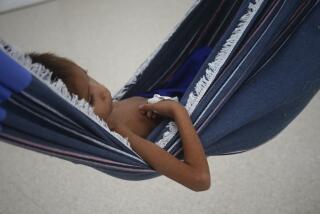Scientists Slowly Drain Poison From Killer Lake in Cameroon
- Share via
LAKE NYOS, Cameroon — It began quietly, with a white mist that bubbled out of this crater lake deep in Cameroon’s mountainous interior. The mist formed into a cloud, dropped over a cliff and poured down lush valleys, speeding silently through sleeping villages.
Minutes later, the placid lake erupted, spewing out an enormous burst of water that created a 200-foot wave--and a concentrated fog of carbon dioxide vented from deep inside the Earth. The cloud blasted through twisting valleys, spreading more than 12 miles before dissipating.
In the villages closest to Lake Nyos, nearly everything died. Helicopters that swept overhead the next day found cows, dogs and birds lying in the green fields and neatly swept dirt yards.
Nearly 90% of the people in the worst-hit villages were dead, many still in their beds where the gas quietly smothered them.
In all, about 1,700 people were killed. The exact number remains unknown.
“It’s printed on my mind,” said Andrew Ewen, a 29-year-old schoolteacher who escaped the gas but lost 15 relatives in the 1986 disaster. “I remember it as the day when everything went wrong.”
*
On a recent afternoon, a small team of Cameroonian scientists watches from an inflatable boat as a thick jet of water shoots skyward from a raft tethered into the center of Lake Nyos. A plastic pipe, about twice the size of a fire hose, drops from the raft for 670 feet into the calm, steel-gray water, nearly reaching the lake floor. With the water shooting out comes something else: carbon dioxide gas.
Fifteen years after Nyos exploded, the lake is slowly--very slowly--being drained of its danger. In February, an international team of scientists successfully completed the first phase in ensuring Lake Nyos does not blow again, installing a venting system to allow gas to escape, and a lake-shore alarm that wails if carbon dioxide levels are too high.
The project, largely financed by a $400,000 U.S. grant, comes none too soon.
The reason why can be smelled in the air, tinged with smoke from brush fires set by farmers burning fields ahead of the planting season. The Lake Nyos area may remain officially off-limits to everyone but scientists and soldiers, but hundreds, if not thousands, of people have returned.
And so has the gas.
“The danger is very high,” said George Kling, a scientist with the degassing team, speaking from his office at the University of Michigan. “The gas in the lake could be released at any time.”
Carbon dioxide, a nontoxic gas that is seldom harmful in small amounts, bubbles up from deep underground, seeping through cracks of old volcanoes throughout Cameroon’s mountains. In most places the gas blows out harmlessly, but at Nyos it builds up in enormous amounts on the lake bottom--trapped by the weight of the water.
An overwhelming gas concentration or a sudden outside factor such as a landslide can churn up the carbon dioxide-laden waters, causing a sudden eruption of gas, much like shaking a bottle of soda. The gas kills by blocking oxygen to the lungs, suffocating its victims.
Today scientists say the carbon dioxide levels in Nyos--and Lake Manoun, a crater lake about 34 miles away where a 1984 gas eruption killed 37 people, and where scientists will soon install a similar vent--are higher than at the time of those disasters.
At Nyos, the single pipe is releasing only slightly more gas than naturally seeps into the lake.
Scientists say they need four or five additional pipes to sufficiently reduce carbon dioxide levels. However, that could cost $2 million more, and there are no donors in sight.
Living with the risk of another eruption is part of daily life for the scientists working at the lake. They know the signs of danger--odd smells, watery eyes--but they also know that if the carbon dioxide alarm goes off and they are unable to race up the hills fast enough to stay above the gas, their last breaths will not be of oxygen.
Few, though, appear worried. To the scientists drawn here from around the world, living on the crater rim in a sprawl of tents and half-built wooden structures everyone calls Nyos City, the lake offers a fascinating phenomenon to study. They quickly get lost in their work.
They can also see the villagers returning.
“At first I was afraid,” said Luc Sigha, a hydrochemist with the Cameroonian team monitoring the venting program. “But we’re giving life to other people here.”
The people around Lake Nyos, impoverished farmers and cattle herders living in mud-walled homes far from electricity and telephones, know a great deal about fear. The survivors remember stumbling through corpse-filled villages. They remember getting out of hospitals to find their homes looted of everything from cooking pots to tin roofs.
They still talk about the strange noises and the stench of sulfur that drifted from the lake that evening. They recall the rumors that sped along the area’s dirt roads after the explosion, rumors of skirmishes, bombs and villages devoid of life.
Still, they are back.
“We have nowhere else we can go,” said Celine Nkeng, a bent-over woman hoeing fields of corn and yams just a few miles away. “This is the only place where we can grow enough food to feed our children.”
The land around Nyos is highly fertile, with a dark, rich soil. Keeping farmers from it--in a country where almost a third of the population is unemployed and 40% live in poverty--is nearly impossible.
“Most of these people were born here and are very attached to their ancestral roots,” said Gregory Tanyileke, a geochemist from Cameroon’s Institute for Geological and Mining Research who runs the program monitoring the vent. “No matter what happens, they’ll return.”
Compounding the situation are lingering beliefs that carbon dioxide had little to do with what happened.
To much of Cameroon, a California-size nation with vast natural resources and a corrupt, often authoritarian government, the Nyos explosion is largely forgotten, a quirk of nature deep in the wilderness.
But it is not forgotten in the villages around the lake.
Many of the people of northwestern Cameroon, the English-speaking minority in this mostly French-speaking nation, are deeply suspicious of their government. They wonder if Cameroonian officials are actually to blame for the explosion--perhaps in a weapons test gone awry.
Others suspect supernatural forces. Tales circulate about a lion that lives there protecting an enormous egg, and old people who turned into buffalo and dove into the water.
Scientists and government officials have met with some elders, explaining the project. But few villagers understand the venting, and many believe--wrongly--that the presence of scientists means all is safe.
“Now that the government is at the lake, it could never happen again,” said David Chia Wamong, 49, who fled his home that August evening, past his neighbors’ corpses. He now lives a few miles farther down the road, on higher ground, in case the lake blows again.
He still cannot explain what he saw, and shrugs at the scientific explanation. What he knows is that the survivors can’t forget what happened.
“People don’t talk about it much anymore,” he said, “but they keep it in their hearts.”
More to Read
Sign up for Essential California
The most important California stories and recommendations in your inbox every morning.
You may occasionally receive promotional content from the Los Angeles Times.










